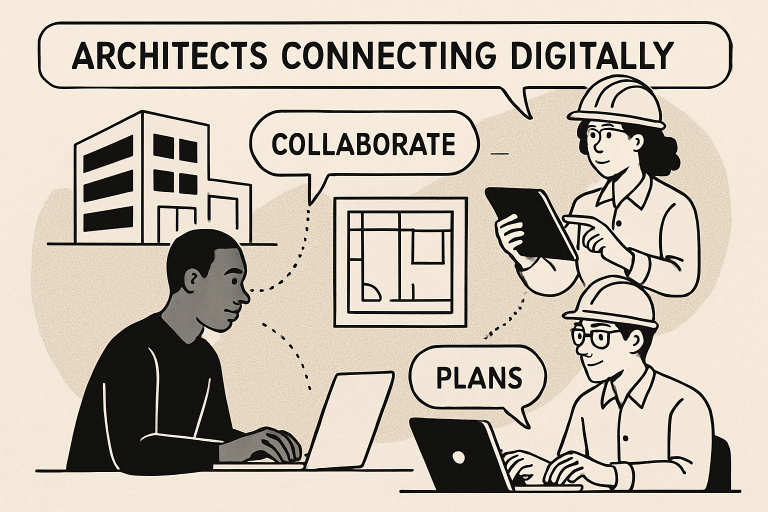Table of Contents
- 1 Introduction
- 2 Key Takeaways
- 3 Enhancing Collaboration Through Digital Tools
- 4 Leveraging Social Media for Professional Growth
- 5 Building Information Modeling (BIM) for Efficient Project Management
- 6 Virtual and Augmented Reality in Architectural Design
- 7 Cloud-Based Solutions and Remote Work
- 8 Future Trends in Digital Architecture
Introduction
The architectural practice is currently undergoing a significant transformation, driven largely by the advent and integration of digital platforms, especially through architects online marketing strategies. These platforms are revolutionizing traditional methods of collaboration, outreach, and innovation within the industry. By harnessing advanced technologies such as cloud computing, 3D modeling, virtual reality, and comprehensive project management software, architects can connect with a global audience and streamline their internal workflows. This technological evolution enables architects to share ideas, seek feedback, and develop designs more efficiently, ultimately enhancing creativity and productivity.
Key Takeaways
- Digital platforms facilitate real-time collaboration and communication among architects and stakeholders.
- Social media and online forums offer architects a platform to showcase their work and connect with a global audience.
- Building Information Modeling (BIM) enhances project coordination and efficiency.
- Virtual and augmented reality tools offer immersive design presentations, improving client engagement.
- Cloud-based solutions support remote work and data accessibility, fostering flexibility in architectural practices.
Enhancing Collaboration Through Digital Tools
Digital communication platforms have become essential and transformative tools in modern architectural workflows, fundamentally changing how professionals collaborate and manage projects. Platforms like Slack, Asana, and Trello offer a wide range of functionalities that facilitate seamless communication among architects, engineers, project managers, and other stakeholders involved in construction and design processes. These tools enable users to exchange messages quickly, share documents such as blueprints, technical specifications, and progress reports, and update task statuses in real-time. They support comprehensive project management features, including setting deadlines, assigning responsibilities, and tracking milestones throughout the project’s lifecycle.
Additionally, these platforms can integrate with specialized software such as CAD, BIM, and scheduling tools, establishing a centralized hub for all project information. Real-time monitoring of project milestones and task completion helps teams identify potential delays or issues early, allowing for prompt resolution and minimizing costly setbacks. These digital platforms also enhance transparency by providing all team members with access to current project data, which fosters accountability and informed decision-making.
By improving oversight and streamlining communication, digital platforms significantly reduce the risk of misunderstandings that can lead to errors or rework. They also promote collaboration across different disciplines and organizational boundaries, ensuring that everyone remains aligned with project goals and deadlines. Ultimately, the integration of digital communication tools into the construction and design processes results in increased efficiency, better resource management, and a higher likelihood of project success, while also supporting sustainable practices through efficient resource utilization and waste reduction.
Leveraging Social Media for Professional Growth
Social media channels have evolved into essential platforms for architects to showcase their work, connect with peers, and attract potential clients. Instagram, Pinterest, and LinkedIn are particularly popular due to their visual-centric nature and professional networking capabilities. These platforms serve as digital showcase galleries, where architects can display high-quality images of their projects, including renderings, photographs of completed structures, and detailed design elements. They also facilitate concise storytelling through captions, videos, and live sessions, enabling architects to share the narrative behind each design. This visibility helps architects gain exposure to a global audience, including industry peers, potential clients, and collaborators from around the world.
Additionally, social media allows architects to gather valuable feedback from their followers, which can inform future projects and professional growth. Engaging in discussions about emerging trends, innovative materials, and sustainable practices fosters a sense of community and continuous learning. Platforms like Instagram and Pinterest utilize algorithms that prioritize visual content, providing architects with a strategic advantage to showcase their creativity and innovation publicly. Furthermore, social media analytics offer valuable insights into audience engagement, enabling architects to tailor their content for maximum impact. Overall, these digital platforms have transformed traditional architecture marketing, making it more accessible, immediate, and interactive, thereby opening numerous opportunities for career advancement and collaboration.

Building Information Modeling (BIM) for Efficient Project Management
BIM, or Building Information Modeling, is widely regarded as one of the most significant and transformative innovations in recent architectural practice. It involves the creation of comprehensive, digital representations of building projects, encompassing every detail from initial concept design to construction and facility management. BIM enables architecture, engineering, and construction (AEC) teams to collaborate more effectively by providing a shared platform where all project data is integrated and accessible. This integration facilitates detailed visualization, precise planning, and accurate scheduling, which significantly enhances coordination among various disciplines. One of the primary advantages of BIM is its ability to identify potential clashes or conflicts—such as utility placements or structural elements—before construction begins, thereby reducing costly errors, rework, and delays on site.
Additionally, BIM supports real-time collaboration, enabling team members from various specialties—such as architects, engineers, contractors, and clients—to work simultaneously on the same digital model, thereby fostering improved communication and informed decision-making. The use of BIM leads to a more predictable construction process, increasing efficiency, reducing waste, and improving overall project transparency. This technological approach also enables teams to more effectively meet ambitious design goals, sustainability standards, and cost constraints, ultimately resulting in higher-quality, more sustainable buildings. Moreover, BIM’s capability to simulate building performance and lifecycle costs provides valuable insights, supporting better long-term decision-making and facility management post-occupancy.
Virtual and Augmented Reality in Architectural Design
Virtual reality (VR) and augmented reality (AR) technologies are revolutionizing the architecture, engineering, and construction industries by transforming how designs are presented, visualized, and experienced. In architecture, VR headsets and immersive software tools enable architects and clients to create detailed virtual walkthroughs of buildings before a single brick is laid. These virtual environments allow stakeholders to assess spatial relationships, proportions, circulation patterns, finishes, lighting, and interior details with high precision, facilitating more accurate design decisions. This immersive experience helps clients gain a clearer understanding of the architectural vision, fostering better communication and enabling early feedback. Consequently, it reduces the likelihood of costly misunderstandings or design changes during construction, saving time and resources.
Additionally, AR technology is used on-site to overlay digital models onto real-world environments through devices like smart glasses or tablets. This capability helps construction teams detect errors, identify clashes, and ensure that building elements are accurately placed according to design specifications. Overall, VR and AR enhance the visualization processes, improve collaboration among stakeholders, and increase the overall efficiency and accuracy of construction projects.
Cloud-Based Solutions and Remote Work
Cloud technology revolutionizes the way architects work by providing instant access to project files and facilitating real-time collaboration regardless of geographical location. Advanced tools like Autodesk BIM 360, which is a comprehensive cloud-based platform for Building Information Modeling, and Trimble Connect, a collaboration platform that integrates designs with project data, empower professionals to synchronize their efforts seamlessly. These systems support various workflows, including remote and hybrid work arrangements, by enabling team members to review, comment on, and update designs asynchronously, thereby reducing delays and enhancing productivity. Additionally, cloud solutions incorporate robust security measures such as encryption, multi-factor authentication, and regular backups to protect sensitive project data from cyber threats. The ability to access and share data securely across multiple devices and locations has become indispensable for modern architectural practices, especially as flexible work arrangements and distributed teams become more common in the industry. This technological shift not only streamlines project management but also fosters a more collaborative and adaptive work environment.
Future Trends in Digital Architecture
The digitalization of architecture remains an ongoing journey, far from reaching its ultimate potential. In the coming years, we can anticipate even more innovative, dynamic, and interactive ways for architects and designers to conceptualize, develop, and bring their visions to life—whether through collaborative efforts or publishing. Emerging and rapidly advancing technologies such as AI-driven design tools, generative design algorithms, and cutting-edge 3D visualization platforms will persistently challenge and disrupt the traditional market landscape, providing architects with unprecedented means to innovate, experiment, and connect on a deeper level. Interactive multimedia publishing, smart building interfaces, and integrated digital communication channels represent exciting frontiers for architectural expression, communication, and impact, opening new possibilities for user engagement and experience. As digital platforms and tools continue to redefine and reshape architectural practice, forward-thinking architects are increasingly leveraging these innovations not only to create better, more sustainable structures but also to foster stronger, more vibrant, and interconnected design communities. By fully embracing digital transformation, these professionals are better equipped to meet the complex challenges of modern architecture—delivering excellence in design, streamlining processes, and enhancing communication in an ever-changing, fast-paced world. Source




